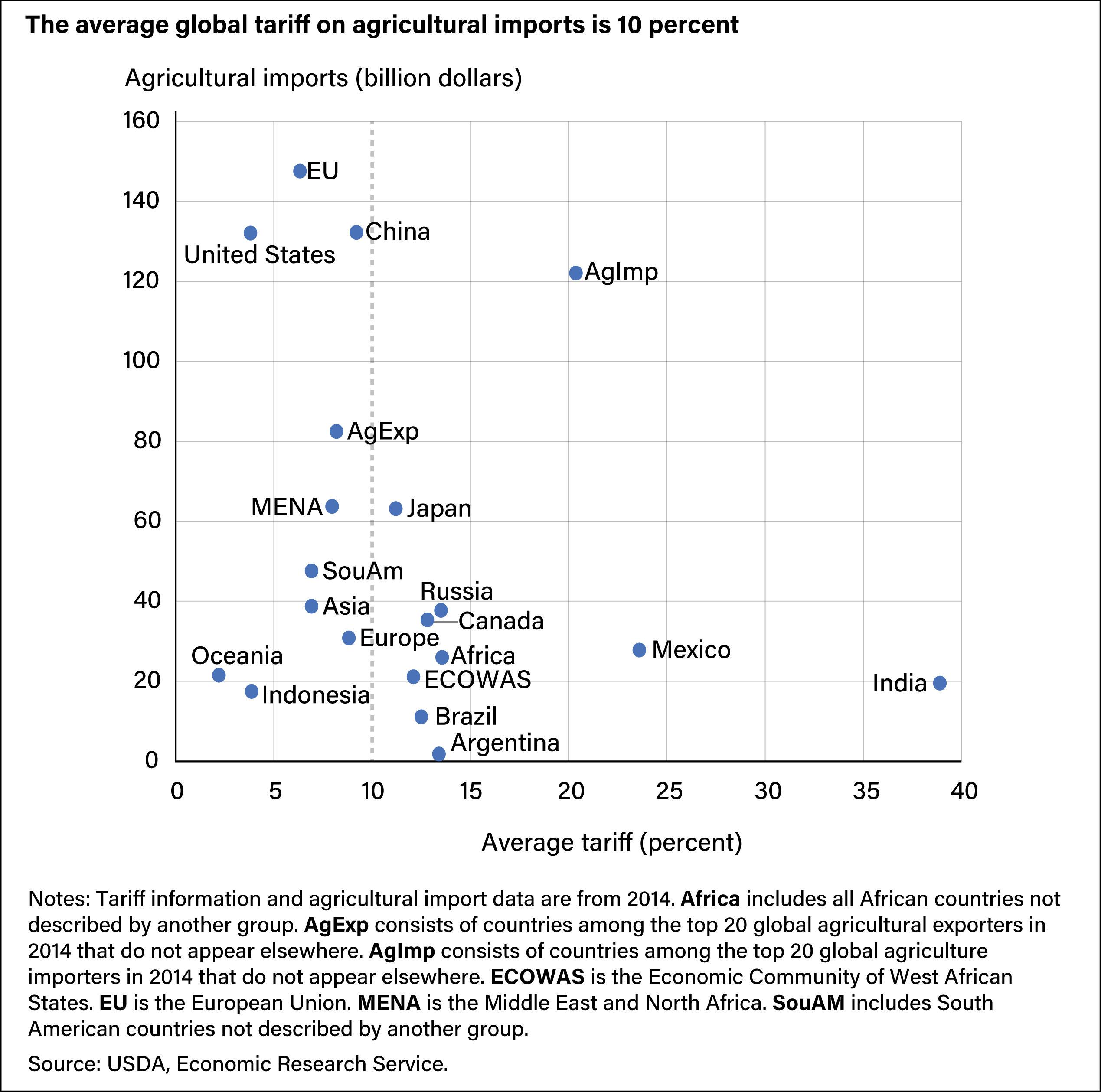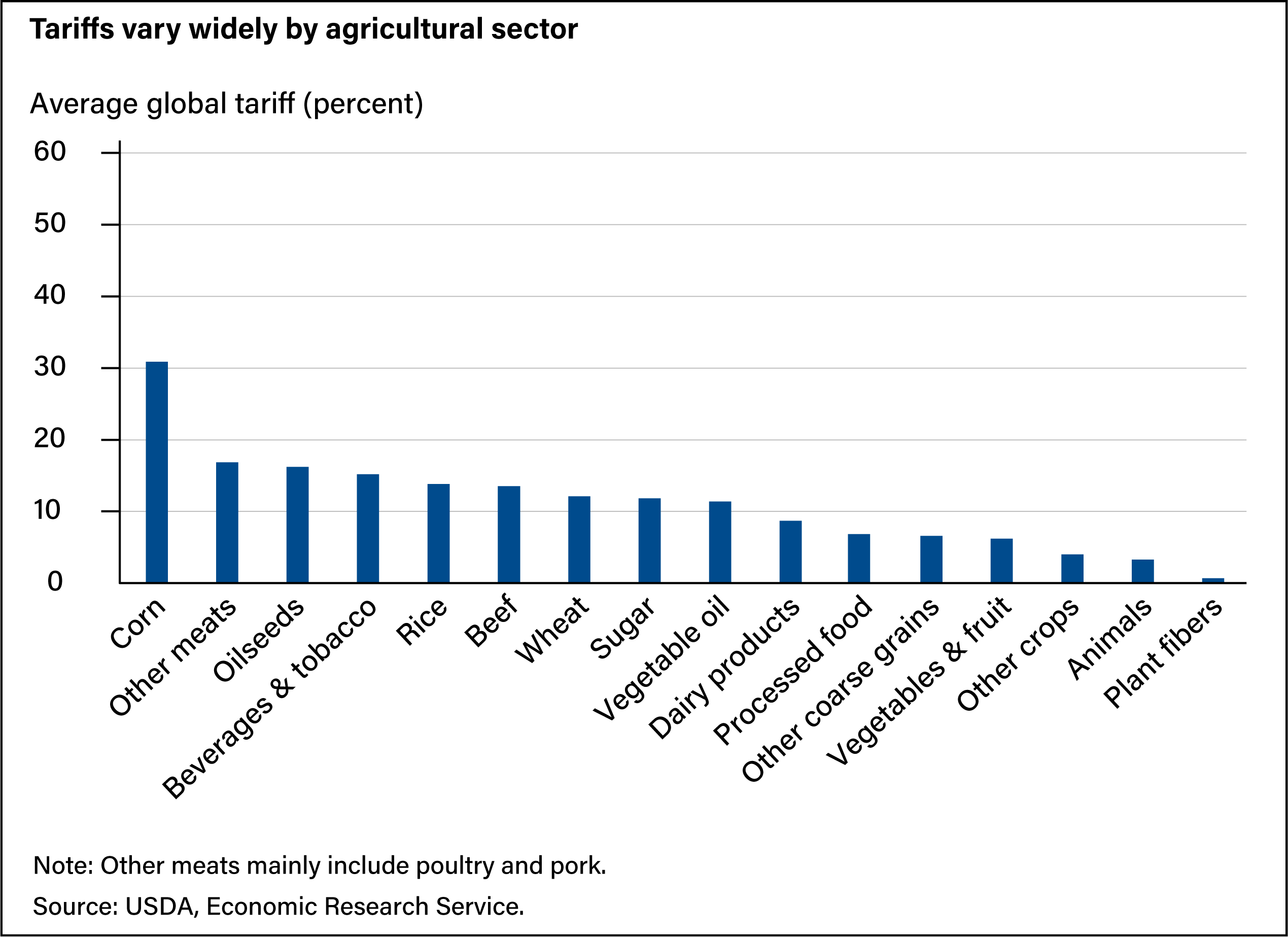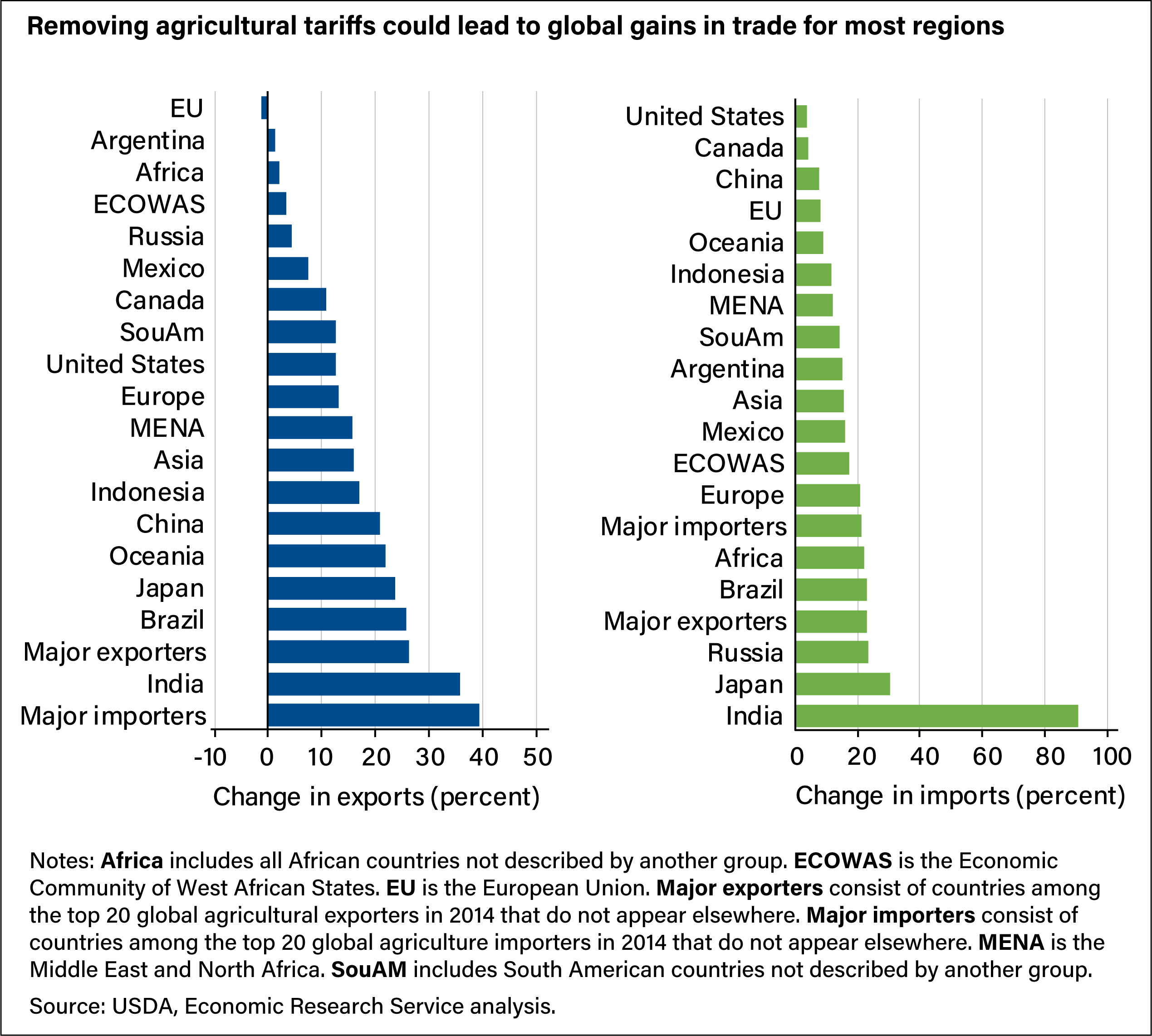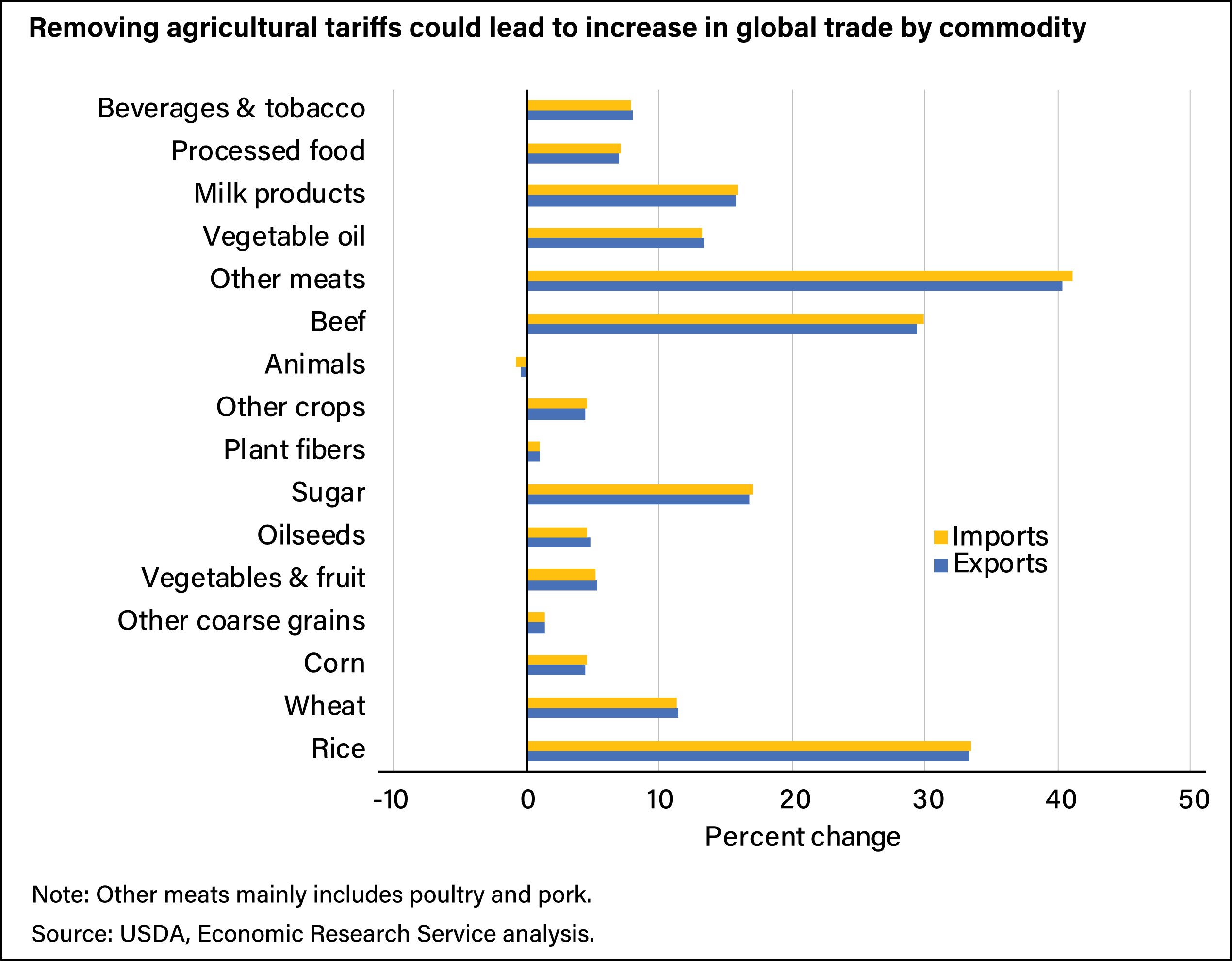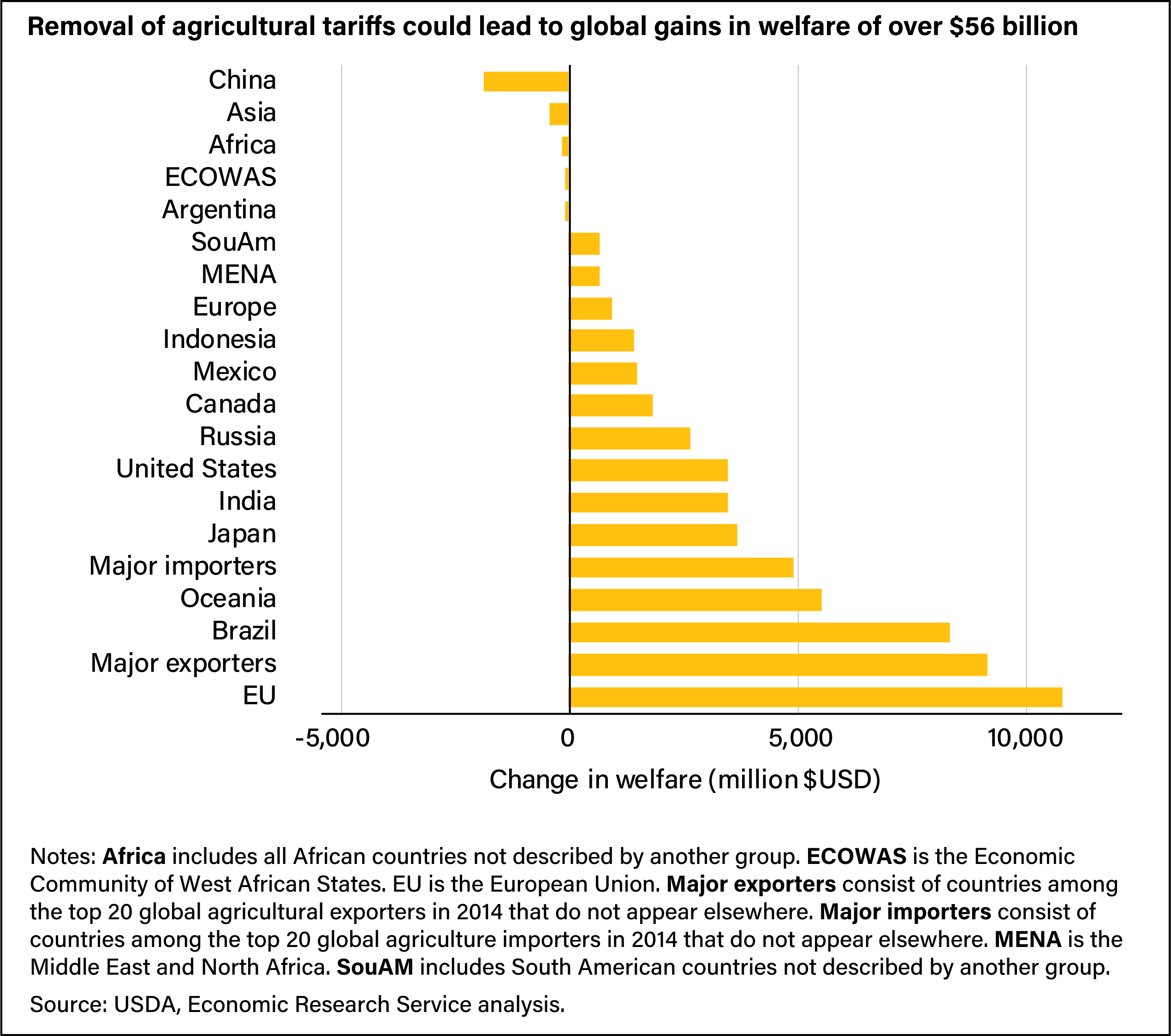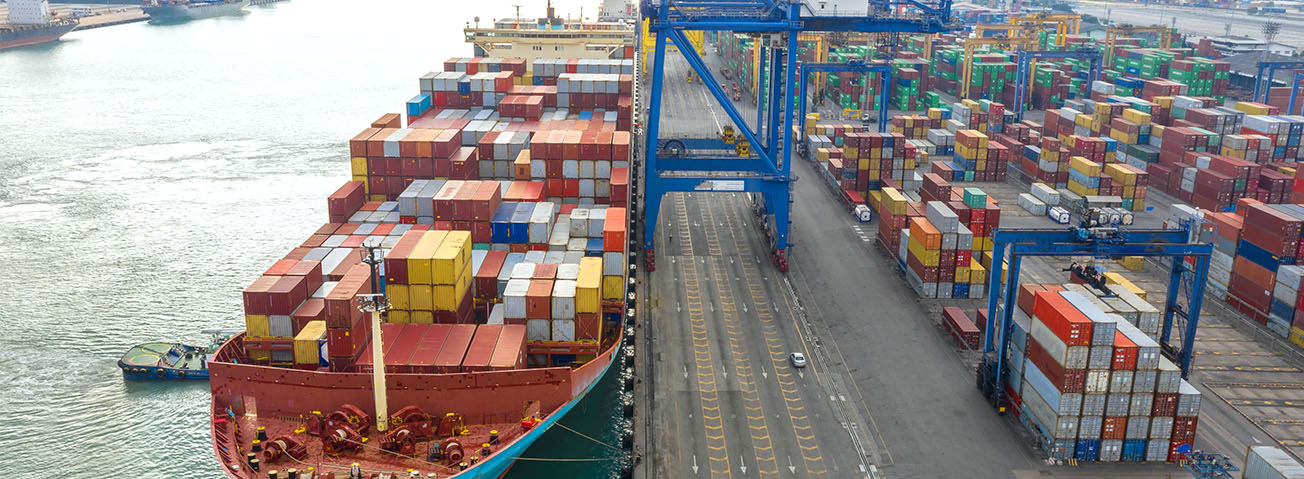
How the Removal of Tariffs Would Impact Agricultural Trade
- by Jayson Beckman and Sara Scott
- 6/7/2021
Highlights
- USDA, Economic Research Service researchers created and studied a hypothetical scenario in which all global agricultural tariffs are removed.
- The simulation showed that without tariffs, global trade would increase 11 percent and would grow in all regions other than the European Union.
- Additionally, a removal of agricultural tariffs would spark an increase in consumer well-being—essentially the equivalent impact of income changes—of $56.3 billion.
Tariffs are a type of tax that governments impose on imports for a variety of reasons, including a way to raise revenue and to protect domestic industries. This latter reason—protection—can come at a cost to domestic consumers in the form of higher prices. The resulting higher prices may stimulate or impede changes in the supply of goods, resulting in impacts on the global balance of trade called “distortions.”
The World Trade Organization (WTO) was formed in 1995 in part to improve market access for trade by negotiating for its members the elimination of barriers, such as bans, that restricted trade by converting them to tariff equivalents. While these tariffs were intended to increase market access for agricultural products, they still can limit trade.
If tariffs do limit trade, what might happen if all agricultural tariffs were removed? A USDA, Economic Research Service (ERS) study addressed that question in a recent report, Reforming Market Access in Agricultural Trade: Tariff Removal and the Trade Facilitation Agreement. ERS analyzed a hypothetical scenario in which all global tariffs are removed on agricultural trade as well as a second scenario in which the reduction of certain trade costs on agricultural goods is facilitated under an agreement overseen by the WTO. The results indicated that global trade and consumer well-being would improve most with the complete removal of tariffs.
What Is a Tariff and Why Would It Limit Trade?
A tariff may be a fixed charge per unit of product imported (specific tariff), a fixed percentage of value (ad valorem tariff), or a combination of both. Tariffs can also be used in combination with a quota, becoming a tariff-rate quota. Tariff-rate quotas provide some market access, but their often high over-quota rates limit how much trade can occur.
Tariffs distort trade markets by affecting the equilibrium price and quantity that would occur in an efficiently operating market. Tariffs raise the price of imported items, which can result in higher prices for imported goods relative to the prices of similarly produced domestic goods. This in turn can have a supply-side impact whereby producers increase production of domestic goods.
Tariffs are the largest source of global economic costs generated from agricultural policy distortions. Efforts to further reduce global market-distorting policies within the WTO have largely stalled, and countries have pursued bilateral and regional trade agreements outside the WTO instead. Even so, agriculture often is still protected in those agreements, so tariffs on agriculture remain high. High tariffs and tariff-rate quotas continue to limit trade for many agricultural products.
Countries apply tariffs to protect domestic industries against price competition from imports. Tariffs are higher on agricultural products than they are on non-agricultural goods in more than 90 percent of countries. That is because in some regions, agricultural products are often deemed “sensitive,” meaning they are important for national security reasons. Furthermore, tariffs on agriculture tend to be much higher than those on non-agricultural products. For example, South Korea’s tariff on agricultural products averages 79 percent compared with 4 percent for non-agricultural imports. In those few instances in which countries tax agricultural imports at a lower average rate than non-agricultural imports, the difference is small.
The average applied global tariff for agriculture is about 10 percent (see chart below). The three largest global importers, the European Union (EU), China, and the United States, all have an average tariff of less than 10 percent. Ten regions included in the study have an average tariff greater than 10 percent and represent 34 percent of global agricultural imports. Regions with an average tariff greater than 20 percent include Mexico, India, and an aggregation of other top agricultural importing countries. India, the region with the highest rates for tariffs, has high rates on most agricultural products, including vegetable oils—the agricultural product it imports the most.
Tariffs also vary widely by agricultural sector. The global average tariff by agricultural sector analyzed in the ERS study is the highest for corn (see figure below). While most regions have small tariffs (5 percent or less) or no tariff on corn, some major importers have high tariffs, largely because of tariff-rate quotas (TRQ). For example, South Korea’s corn tariffs average 328 percent as part of its TRQ. Of the other agricultural commodities, the category that includes poultry and pork (known as “other meats”) has the second-highest average tariff (17 percent), followed by oilseeds (at 16 percent, and again attributable to South Korea’s high out-of-quota rate). However, countries with high tariff-rate quotas sometimes have used additional TRQs, with lower in-quota rates, in response to high commodity prices, according to a 2014 USDA, Foreign Agricultural Service report.
Most Regions Would See Increases in Imports, Exports
To simulate the effects of the total removal of agricultural tariffs, ERS used a computable general equilibrium (CGE) model. A CGE model is a large system of equations and data that links commodities, regions, and economic agents together to calculate the potential effects of a change in policy. In this study, the model separated the agricultural sector into 16 commodities and divided global regions into 20 entities, some being individual countries and others being country groupings. This allowed for a more precise analysis of the agricultural sector.
The model simulated the removal of all tariffs on agricultural commodities and reported estimated changes to agricultural trade, production, prices, and welfare. It stated the effects of trade in terms of changes in relative values, not in volume. The results indicated that by removing agricultural tariffs, global trade would increase by more than 11 percent.
Results indicated that the largest export gains would occur in regions that are already large agricultural exporters. All regions other than the EU would realize an increase in agricultural exports as well as imports (see chart below). The EU would potentially experience a slight decrease in exports due to the lost markets for its meat products.
Under the simulation, India’s imports would incur the largest increases in values, probably because India’s agricultural tariff is the highest overall at nearly 40 percent. For the United States, imports would increase just under 4 percent, and exports would increase 13 percent.
Global demand for specific commodities played a role in the simulated trade changes. By commodity, the “other meats” group, rice, and beef showed the largest potential increase in exports from tariff removal (refer to chart below). The large increase in other meats could be attributed to high tariffs in many regions, including the EU. On the other hand, much of the global population consumes rice, explaining the large increase in its trade. Some commodities indicated very little change in trade, and live animals showed a decrease.
Consumer Well-Being Could Improve
Removing agricultural tariffs could lead to global gains in welfare, a calculation of consumer well-being measured by changes in consumer income (see chart below). The ERS model indicated that consumer welfare—essentially the equivalent impact of income changes—could increase by $56.3 billion if all tariffs on agricultural commodities were removed—more than 2 percent of the global value of the agricultural sector. The regions estimated to experience the largest welfare gains are the EU ($10.8 billion) and Brazil ($8.3 billion), as well as a category of major agricultural exporters that do not appear in other groupings ($9.1 billion). Some regions would experience a loss in welfare, including China ($1.9 billion), Asia ($428 million), Africa ($150 million), and the Economic Community of West African States ($53 million). However, the model projected that all regions would experience an increase in consumer well-being for the portion of the economy attributable to the agricultural sector. Consumer welfare from agriculture would increase by more than $49 billion, meaning that non-agriculture would increase by $7 billion. Consumer well-being in the United States would increase by $3.5 billion.
This study demonstrates the potential benefits to agricultural trade from changes in policy and the reduction of trade costs. Global agricultural trade could increase if tariffs on agriculture were removed or trade costs were reduced. The removal of tariffs could shift resources away from commodities that might be inefficient toward the production of commodities that could be produced more efficiently. However, although these gains could represent an increase in agricultural market access, other non-tariff measures—such as sanitary or technical regulations—could linger and continue to limit market access.
Errata: On June 29, 2021, text on South Korea’s corn tariff and the accompanying data point on the global corn tariff in the second figure were revised to correct errors that occurred in data transmission. No other data was affected by the error.
This article is drawn from:
- Beckman, J. (2021). Reforming Market Access in Agricultural Trade: Tariff Removal and the Trade Facilitation Agreement. U.S. Department of Agriculture, Economic Research Service. ERR-280.
You may also like:
- Beckman, J., Dyck, J. & Heerman, K.E.R. (2017). The Global Landscape of Agricultural Trade, 1995-2014. U.S. Department of Agriculture, Economic Research Service. EIB-181.
We’d welcome your feedback!
Would you be willing to answer a few quick questions about your experience?


